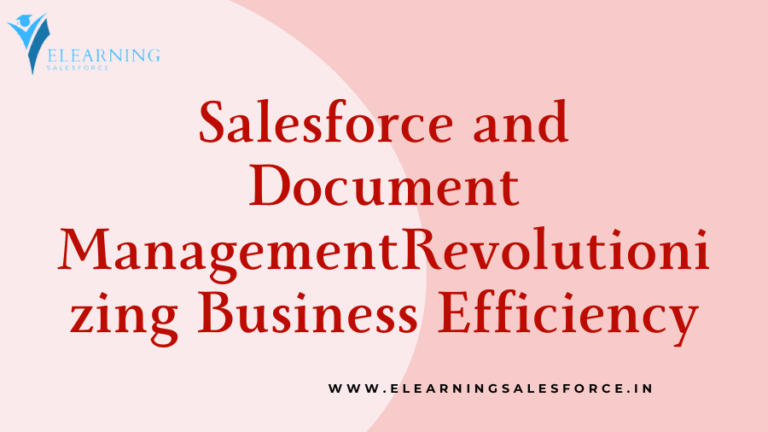Introduction: Salesforce, a leading Customer Relationship Management (CRM) platform, has become an integral part of businesses across various industries. Its powerful features, robust data management, and extensive customization options make it a go-to solution for managing customer relationships and streamlining sales, marketing, and service processes. However, to truly unleash the full potential of Salesforce, organizations must integrate it with other applications in their technology stack. In this blog, we will explore the benefits, challenges, and best practices of integrating Salesforce with other applications to achieve a seamless and efficient business ecosystem.
Why Integrate Salesforce with Other Applications?
- Data Synchronization: Integration allows for real-time data synchronization between Salesforce and other applications. This ensures that all teams have access to the most up-to-date and accurate information, leading to better decision-making and improved customer interactions.
- Streamlined Workflows: Integrating Salesforce with other tools automates repetitive tasks and eliminates manual data entry. This streamlines workflows and frees up valuable time for employees to focus on more strategic activities.
- Improved Customer Experience: A comprehensive view of customer data from various touchpoints enables organizations to deliver personalized and consistent experiences. This enhanced customer experience can lead to increased customer satisfaction and loyalty.
- Enhanced Analytics and Reporting: By consolidating data from different systems, businesses can generate more comprehensive reports and gain deeper insights into their operations. This, in turn, facilitates data-driven decision-making and performance analysis.
Key Challenges in Salesforce Integration
- Data Complexity: Different applications may store data in various formats and structures. Merging this data can be complex, requiring careful data mapping and transformation.
- Integration Costs: Integrating Salesforce with other applications may involve costs related to software licenses, middleware, and development efforts. Organizations should consider the long-term benefits before investing.
- Security and Privacy Concerns: Integrating applications may expose sensitive data to potential security risks. Ensuring proper encryption, authentication, and authorization measures are in place is crucial.
- Customization and Maintenance: Integration projects often require custom development to tailor solutions to specific business needs. Regular maintenance is also necessary to adapt to changing requirements and updates.
Best Practices for Salesforce Integration
- Define Clear Objectives: Before beginning the integration process, clearly outline the objectives and expected outcomes. Align integration goals with broader business objectives to ensure relevance and value.
- Choose the Right Integration Approach: There are various integration methods available, including point-to-point integration, middleware-based integration, and API-based integration. Select the approach that best fits your organization’s needs and future scalability.
- Leverage Salesforce APIs: Salesforce offers robust Application Programming Interfaces (APIs) that enable seamless communication with external systems. Utilize these APIs for secure and efficient data exchange.
- Prioritize Data Quality: Data accuracy and consistency are essential for successful integration. Implement data validation and cleansing processes to maintain high-quality data across systems.
- Conduct Rigorous Testing: Thoroughly test the integration solution before deployment to identify and rectify any potential issues. Include end-to-end testing to ensure smooth data flow across integrated applications.
- Implement Security Measures: Safeguard sensitive data by employing encryption, access controls, and user authentication. Regularly audit security measures to ensure compliance with industry regulations.
- Provide User Training and Support: Properly train employees on the integrated systems and provide ongoing support to address any questions or challenges they may encounter.
Examples of Salesforce Integration
- Salesforce and Marketing Automation: Integrating Salesforce with marketing automation platforms like Marketo or HubSpot enables seamless lead generation, nurturing, and tracking, providing a holistic view of the customer journey.
- Salesforce and ERP Integration: By integrating Salesforce with Enterprise Resource Planning (ERP) systems like SAP or Oracle, businesses can streamline order management, invoicing, and inventory management processes.
- Salesforce and Customer Service Integration: Integrating Salesforce with customer service applications like Zendesk or ServiceNow allows support agents to access customer data and interactions, leading to more personalized customer service experiences.
- Salesforce and E-commerce Integration: Integrating Salesforce with e-commerce platforms like Shopify or Magento facilitates order processing, inventory management, and customer data synchronization between sales and online stores.
Which tool is integrated with Salesforce?
Salesforce integrates with a wide range of third-party tools and applications to enhance its capabilities and provide a more comprehensive solution for businesses. Some of the commonly integrated tools include:
- Microsoft Outlook and Office 365: Integration with these tools allows users to sync emails, contacts, and calendars between Salesforce and Outlook/Office 365, enabling seamless communication and data sharing.
- Gmail and Google Workspace: Similar to Outlook integration, users can sync their Gmail emails, contacts, and events with Salesforce.
- Marketing Automation Platforms: Tools like HubSpot, Marketo, and Pardot can integrate with Salesforce to streamline marketing campaigns, lead nurturing, and tracking of customer interactions.
- Analytics and Business Intelligence: Applications such as Tableau and Einstein Analytics (now known as Tableau CRM) can integrate with Salesforce to provide advanced data visualization and analytics capabilities.
- ERP and Accounting Systems: Integration with ERP systems like SAP and accounting software like QuickBooks enables smooth data flow between front-end CRM processes and back-end financial systems.
- eCommerce Platforms: Integration with platforms like Shopify and Magento allows businesses to manage online sales, customer data, and order information within Salesforce.
- Communication and Collaboration Tools: Tools like Slack and Microsoft Teams can integrate with Salesforce, facilitating communication and collaboration among team members.
- Document Management: Integration with document management platforms such as SharePoint and Box enables seamless sharing and access to important documents and files.
- Customer Support Systems: Tools like Zendesk and ServiceNow can integrate with Salesforce to create a unified customer support experience.
- Integration Platforms: Middleware and integration platforms like MuleSoft and Dell Boomi are used to connect Salesforce with various other applications and systems, enabling data synchronization and process automation.
- Social Media Management: Integration with tools like Hootsuite and Social Studio allows businesses to manage social media interactions and track social media data within Salesforce.
- Payment Gateways: Integration with payment gateways like PayPal and Stripe allows businesses to handle transactions and payments directly within Salesforce.
These are just a few examples of the many tools that can integrate with Salesforce. The ability to integrate with diverse systems and applications is one of the key strengths of the Salesforce platform, enabling businesses to create customized, end-to-end solutions that meet their specific needs.
Conclusion
Integrating Salesforce with other applications is not just an option; it is a necessity for organizations looking to create a unified and efficient business ecosystem. By connecting Salesforce with various tools and systems, businesses can unlock the full potential of their data, streamline workflows, and deliver exceptional customer experiences. However, successful integration requires careful planning, a clear understanding of business objectives, and the right approach to match the organization’s needs. With the right strategy and adherence to best practices, businesses can achieve seamless connectivity and maximize the value of Salesforce integration to drive growth and success.




